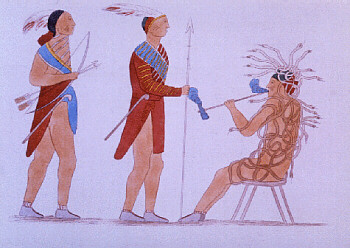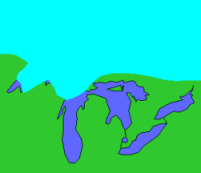

Nicholas R. Adams
Palaeo-Indians were the earliest prehistoric people in Ontario. Small bands of hunters moved north into Ontario as the land became ice free after the last ice age, about 11,000 years ago........
BEFORE HUMAN SETTLEMENT OF ONTARIO
During much of the last 90,000 years, Ontario has been covered in thick ice sheets of the Wisconsinan glaciation. The ice sheets reached their maximum extent and thickness about 20,000 years ago. The Wisconsinan stage of the Pleistocene period occurred between 80,000 and 10,000 years ago. It was the most recent period of glaciation in North America.
16,000 YEARS AGO
After reaching its maximum about 20,000 years ago, the ice covering Ontario gradually melted back. Parts of southwestern Ontario became ice free by 16,000 years ago. This period is called 'the Erie Interstade'. Around 15,000 years ago, during the 'Port Bruce Readvance', it became colder and the ice advanced southwards past the south shore of Lake Erie.
14,000 YEARS AGO
A milder period, called the 'Mackinaw Interstade' followed, again revealing dry land in southwestern Ontario. A further cold period caused the 'Port Huron Readvance' around 13,000 years ago, but this time much of southwestern Ontario stayed ice free. By 12,000 years ago, plants and animals had begun to colonize the newly revealed land. People soon followed.
12,000 YEARS AGO

Approximate Ice Position 12,000 years ago
As the ice sheets retreated a series of large pro-glacial lakes formed between the land to the south, and the edge of the ice. As people followed the retreating ice, they were attracted to the rich environment along the lakes shores. Many of the earliest Palaeo-Indian sites in Ontario have been found along the margins of Lake Algonquin and Lake Iroquois.
AFTER 10,000 YEARS AGO
The ice in the Great Lakes basin continued to melt back, exposing the whole of the Lake Huron basin. A large lobe of ice still occupied parts of the Lake Superior basin until about 9,000 years ago, splitting it into two parts. The first known human occupation in the upper Great Lakes occurred while ice still lay in the Lake Superior basin.
EARLY PALAEO-INDIAN PERIOD - POPULATION
The Early Palaeo-Indian population in southern Ontario was probably never very high. Archaeologists have suggested that perhaps fewer than 200 people lived in the whole region. The distributions of Early Palaeo-Indian sites suggest that two main groups may have occupied the area; one group ranging between the west side of Georgian Bay and the Parkhill area of southern Lake Huron (and perhaps west into Michigan), the other ranging along the shores of Lake Admiralty (a predecessor of Lake Ontario)
Most Early Palaeo-Indian sites are known from spreads of chert debris. Few features (hearths, pits etc), no evidence of structures, and few bone remains have been recovered. This rather limited evidence means that the emerging picture of Early Palaeo-Indian life is based on the extremely detailed analysis of chert flakes and artifacts, careful interpretation of the patterns of distribution of artifacts within sites, and detailed reconstruction of the geographical and environmental setting of the site.
The majority of sites were probably temporary camps from which hunting parties would range, where tools would be made or reworked, where skins and clothing would be made. The archaeological sites which resulted from these activities tend to be small and ephemeral, distinguished only by a restricted spread of flakes.
EARLY PALAEO-INDIAN SITE LOCATION CHARACTERISTICS
With the exception of the sites in the Rice Lake area (see Plainville) most Early Palaeo-Indian sites have been found on, or close to relic shorelines of glacial lakes. While many archaeologists believe that this represents survey bias, and a more dispersed and less focussed pattern of settlement would be closer to the truth, there seems little doubt that the shores of glacial lakes Algonquin and Iroquois provided an attractive environment for Early Palaeo-Indian settlement.
People may have been attracted to the land close to the lakeshore for a number of reasons. Cold winds blowing off the lake may have prevented a closed forest from growing in the area. This would have provided hunters with good visibility along the lakeshore and attractive grazing for herbivorous mammals. The more open, breezy environment may also have been more insect free than the surrounding country - a benefit to humans and animals alike. Fishing and wildfowling would also have been possible subsistence activities, providing important supplements the diet of the people. Lastly, although there is no direct evidence to support this notion, Palaeo-Indian people may have used the lake for travel. Winter lake travel would certainly have been possible, and it concievable that boats of some kind were also in use during the summer.
As suggested above, not all Early Palaeo-Indian sites were located along the lakeshore. Some have been found along glacial lake shores (such as lakes Warren and Whittlesey) which would have been dry long before they were inhabited and others have been found well away from glacial lake shores. In these instances, it seems that the local environment was what attracted the people. Sites were situated on well drained higher land overlooking areas of poorly drained land (ie. former lakebed, or swamp). This variety in environmental conditions may have been attractive to game, and this may have been what attracted the people.
PARKHILL COMPLEX
The Parkhill Complex is an Early Palaeo-Indian complex recognized in southern Ontario and adjacent parts of Michigan. Excavations at the Parkhill (Brophey) site in southwestern Ontario and at the Fisher Site on Georgian Bay have recovered Barnes type fluted points. Although they are separated by more than 160 kilometres, the similarities in tool types and more specifically in the materials that they were made off, have led researchers to speculate that the same people occupied the two sites.
Outcrops of Fossil Hill (Collingwood) Chert on the edge of the Niagara Escarpment may have attracted these people to the Fisher Site on the west side of Georgian Bay. The concentrations of Early Palaeo-Indian 'Parkhill Complex' sites in the vicinity of Parkhill suggests that this area was a terminus of a caribou hunting cycle which annually took these people across the northern part of central Ontario.
PLAINVILLE COMPLEX
The 'Plainville Complex' is a term that has been applied to a group of Early Palaeo-Indian sites in the southern Rice Lake region, near Peterborough, Ontario. These sites are not situated on or near specific glacial Great Lakes shoreline features, rather they appear to be oriented towards an interior stream valley parallel to the Rice Lake basin.
Lawrence Jackson, the principal researcher of Plainville Complex sites argues that the interior valley would have been ideal for caribou and that it was the presence of these animals which attracted the people to the area. Rice Lake is known to have been an important deer hunting area in the recent historic past. Recent discoveries of caribou bones in Rice Lake marshes have firmly demonstrated that caribou were present in the area during the Archaic period. Jackson argues that on the basis of this evidence, it is likely that they were also present during the Palaeo-Indian period.
Early Palaeo-Indian artifacts collected or excavated from sites in the region are mainly made of Fossil Hill (Collingwood) chert. They include fluted points, end scrapers, gravers and preforms.
EARLY PALAEO-INDIAN POINTS AND TOOLS
Three main types of Fluted Point have been recognized in Ontario from the Early Palaeo-Indian Period: Gainey, Barnes and Crowfield.
CROWFIELD POINTS (ca. 10,500 B.P.)
Crowfield Points are thin, wide and expand out from the base often to a pentagonal form. The basal concavity tends to be shallow and they do not have the fishtail shape of Barnes Points. These points often have multiple flutes. Crowfield Points are thought to date to a slightly later period than Gainey or Barnes types. These points are often made of Onondaga Chert. Examples in Collingwood chert are less common.
BARNES POINTS (ca. 10,700 B.P.)
Barnes points are an early Palaeo-Indian point type thought to be slightly later in date than Gainey Points. They are the diagnostic point type of the 'Parkhill Complex'. They average about 6 cms. long and have prominent 'fishtails' below a distinct waist. These are usually well made points with parallel flaking and carefully executed flutes. Most Barnes points in Ontario are made of Collingwood or Onondaga Chert.
GAINEY POINTS Ca. 10,900 B.P.
Gainey Points are the oldest known Palaeo-Indian fluted point type in Ontario. They are the largest point form from this period, measureing up to 10 cms. in length . They tend to be thick, with a deep basal concavity and poorly developed 'ears'. They are usually parallel sided. Fluting is often minimal or incomplete. Gainey Points have been found made of Collingwood chert, however southern cherts such as Onondaga, Upper Mercer and Flint Ridge tend to be more common. They are named after an archaeological site in Michigan.
Although fluted points are by far the most recognisable tool produced by Early Palaeo-Indian people, they manufactured a wide variety of other stone tools including scrapers, gravers and burins.
BIFACES
Early Palaeo-Indian people also made a variety of bifacial tools. These include large bevelled knives, backed knives, utilized bifaces and pieces esquillee or 'wedges'. Utilized bifaces were usually tool blanks which had failed during processing. These and the knives were undoubtedly used for a wide variety of cutting tasks. The 'wedges' are more problematic, although it is generally thought that these distinctive rectangular bifaces were used for splitting wood or bone, since their working edges are often heavily battered.
UNIFACES
Tools with working from a single edge are called unifaces. Common unifacial tools on Early Palaeo-Indian sites include end scrapers, side scrapers and a variety of flake tools. Trianguloid end scrapers are particularly distinctive, having a roughly triangular outline, with a steep working face. Some examples are retouched along the sides to create a tapering form. Their form suggests that they were hafted. Some examples have small projections or notches at the edge of the working face, suggesting that they were multi-purpose tools. Concave side-scrapers are assumed to have worked like spokeshaves.
PIERCING TOOLS
A number of specialized tools are frequently found on Early Palaeo-Indian sites. These include gravers, beaks, burins and spokeshaves. Gravers are flake tools with small, sharp projections or 'spurs'. These are assumed to have been used for perforating soft materials. Larger, heavier flake tools with points are usually referred to as 'beaks'. These were probably used for slotting or hollowing wood or bone.
